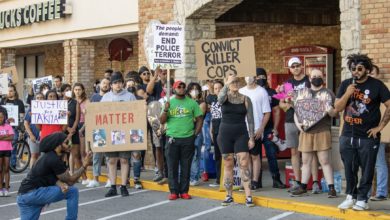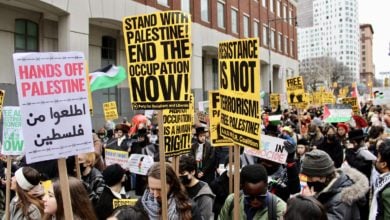After deliberating for approximately two hours yesterday, the jury in a federal civil rights case against Anaheim Police Department and Officer Nick Bennallack came to a “not guilty” verdict. The jury determined that no excessive force was used when Bennallack shot unarmed Manuel Diaz in the back despite having committed no crime.
The execution-style murder of Diaz was witnessed by numerous neighbors who then gathered on the street to demand answers from the police. The police response to the community was broadcast across the nation when rubber bullets were fired at small children and a police dog was unleashed on the community, mauling a young father whose newborn baby was nearly bitten. Several arrests of bystanders were made at the scene.
The following day a mass protest took over the Anaheim police headquarters for several hours demanding justice. That night Anaheim PD murdered Joey Acevedo and the community of Anaheim and their allies took to the streets for several days of intense demonstrations that were violently suppressed by Anaheim PD and other surrounding police agencies.
One year later Manuel Diaz’s mother, Genevieve Huizar, alongside Joey Acevedo’s mother, called on all people of conscience and all families who suffer from police violence to converge in Anaheim to demand justice for all. Nearly two thousand people descended upon Anaheim and over fifty families affected by police violence, marking the first major action taken by a growing statewide, coordinated movement.
Vile defense exposes the police
The defense put forth the most vile assertions and character assassination as their general strategy. The closing argument of the lead defense attorney, Steven Rothans, representing Officer Bennallack and Anaheim PD, relied upon the racist preconceived notions of jurors while ignoring the facts of the shooting.
The assertions of Rothans only served to expose the role of police in society. He repeatedly reminded the jury that Diaz “wasn’t shot in Downtown Disney,” and that he was “dressed like a gang member,” when he was found in “a gang neighborhood.”
After admitting that the officers never saw anything in the hands of Diaz that looked like a gun, Rothans made the ludicrous statement that “concealed hands equal concealed weapons,” repeating it ad nauseum.
After admitting that Diaz had not committed any crime, he stated, “The entire situation changed when Manuel made the decision to run.” But of course, this statement contradicts California law, which states that any person who runs when confronted by police is subject to being detained—not executed, a fact presented by the prosecuting attorney, Dale Galipo.
Rothans continued, “A police officer in the state of California does not need to see a weapon to shoot someone.”
And when addressing damages, the amount to be paid for the loss of Manuel’s life, Rothans cynically referenced Diaz’s struggle with methamphetamine as a measure of his value. Rothans even asserted that Galipo’s request for damages for Diaz’s pain should be rejected by the jury because he died quickly and therefore experienced no pain. Apparently Steven Rothans, an attorney who has built a multi-million dollar career from defending killer cops and their corrupt departments, believes being shot to death is painless.
Rothans attacked Galipo’s attempt to show Manuel Diaz’s loving, and family-oriented nature by saying that none of this was part of Officer Bennallack’s knowledge at the time of the incident and is therefore irrelevant. But of course, U.S. District Court Judge James Selna allowed evidence that Rothans used to demonize Diaz—evidence that Bennallack had no knowledge of at the time of the incident. This evidence included photos taken from his cell phone after he died of Diaz holding a gun as well as a report that alleged Diaz had methamphetamine in his system the day he was murdered. Rothans also attempted to use Diaz’s tattoos to characterize him as a criminal.
But Bennallack had no knowledge of Diaz’s use or lack of use of drugs and could not see any of his tattoos from his initial encounter. Bennallack certainly couldn’t see any photos on a cell phone. But Rothans, who claimed only the facts that were present to Bennallack should be considered, relied upon repeatedly showing photos of Diaz holding a gun. This characterization and its affect on the jury highlight a deeply racist view of gun ownership. A tattooed white male posing with his guns is a champion of the Second Amendment and a conservative hero resisting the attempts of the government to allegedly disarm the people. But a tattooed Latino male posing with his guns is a street criminal who should be executed on sight by cops regardless of any factual circumstances at the time of the incident.
The sum of the facts make it simple: Manuel Diaz had not been witnessed committing a crime; no officer saw any weapons or objects in his hands that looked like weapons, the encounter lasted about 20 seconds including the foot pursuit; Diaz was shot twice with the bullet trajectory passing from the back to the front proving that he had not turned around or made any threatening gesture to cops. Bennallack gave no warning that he would fire and had countless other non-lethal options.
What the jury did by finding Bennallack “not guilty’”was state very clearly that any person who dresses a particular way and is standing in a poor neighborhood can be shot regardless of whether or not they committed a crime or possess a weapon. This was the admission of Rothans himself when he told the jurors that they needed to consider that Diaz was wearing a baggy shirt and was in a neighborhood where gangs existed. When he referenced Disneyland he admitted quite openly that the police in Anaheim should kill people in working class and poor neighborhoods but shake hands at wealthy tourist attractions.
Often when activists in the police brutality movement argue that police act as an occupying force, shooting people on sight in poor neighborhoods with impunity, they are attacked as being “delusional” or “radical”. But this very line of argument was the defense that got Bennallack off. Rothans said that this is precisely the role that police officers play in society and it should be considered completely justifiable.
After being asked regarding their two hours of deliberation one juror expressed that their decision was based on the fact that Diaz was in a gang neighborhood and was dressed like a gang member, showing that Rothans’ goal of demonizing Diaz and avoiding the facts worked. Four of the jurors were white, three Latino, and one Asian. The average age of the jurors was roughly 40 years old. When this is coupled with the fact that most working class people can not afford to spend a week in a jury box and that any person that speaks badly of the police from their experiences is typically excluded from any jury it becomes quite clear that this was not a trial by a jury of Manual Diaz’s peers as promised in the U.S. Constitution. This jury did not have very much personal experience with so-called gang neighborhoods and their fear and vilification of these neighborhoods on the basis of media coverage informed their ultimate decision.
Media lies
The very first article out came from the OC Register’s Claudia Koerner, who lied about the incidents in 2012 when she wrote, “The killing led to a disturbance when a crowd swarmed police headquarters.” Actually, a disturbance occurred when police shot rounds at children and unleashed a vicious attack dog on the community.
Amy Taxin wrote an equally disgusting piece for the Associated Press that was widely reposted. She also attempted to characterize the community as violent rioters while saying nothing about the police attack on innocent bystanders that immediately followed the execution of Manuel Diaz in front of the community.
The Los Angeles Times article written by Adolfo Flores summarizes all the lies of Bennallack without sharing any of the damning evidence against his account. For instance, Flores included Bennallack’s claim that Manuel was turning around when shot but failed to include Bennallack’s sworn testimony stating that he could only see Diaz’s back when he fired the two shots that killed him – meaning Diaz had never turned around. Flores also failed to report the testimony of other key witnesses who stated that Diaz did not toss any objects as he was running.
CBS Los Angeles claimed that Manuel had reached in his waistband but the evidence at trial clearly indicated that no officer could see his hands as he ran away, so how exactly could they see that he had reached in his waistband? They described justifiable protests at well documented police brutality against the community as merely, “anti-police.” NBC and KTLA used similar reporting strategies. In short, this denial of justice was used by the mass media as another opportunity to carry out public relations on behalf of Anaheim PD and another opportunity to vilify the oppressed communities of Anaheim.
The struggle continues
Huizar told reporters, “Justice was not served today, not for my son and not for Orange County. I’m disappointed but I’m not broken. We are going to appeal.”
After protesting outside the federal court in Santa Ana, Huizar walked down the street to a local barber in order to shave her head in honor of her son. She has vowed to continue to struggle not only for her son’s justice but for the justice of all victims of police brutality and is a shining example of leadership in that struggle. Not long after this verdict she stood shoulder to shoulder with the family of Martin Hernandez, who was killed on March 6, 2012 by Anaheim police officer Dan Hurtado.






